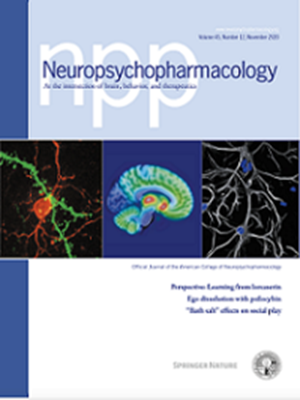Timing matters: modeling the effects of gestational cannabis exposure on social behavior and microglia in the developing amygdala
IF 6.6
1区 医学
Q1 NEUROSCIENCES
引用次数: 0
Abstract
Cannabis is the most frequently used illicit drug during pregnancy, with use steadily increasing in the United States as legalization and decriminalization expand to more states. Many pregnant individuals use cannabis to reduce adverse symptoms of pregnancy, considering it to be less harmful than other pharmaceuticals or alcohol. The primary psychoactive component of cannabis, delta-9-tetrahydrocannabinol (THC), is a partial agonist of the candidate receptors of the endocannabinoid (eCB) system cannabinoid receptor 1 (CB1R) and 2 (CB2R). However, whether it perturbs neural development of the fetus is poorly understood. Previously we have shown that androgen mediated eCB tone in the developing amygdala promotes microglial phagocytosis of newborn astrocytes which has enduring consequences on the neural circuits regulating sex differences in social behavior. Microglia are the resident immune cells of the brain and express both CB1R and CB2R, making them likely targets of modulation by THC. It is also plausible that exposure to THC at differing gestational timepoints can result in distinct outcomes, as is the case with alcohol exposure. To model human cannabis use during either late or early pregnancy, we exposed rodents to THC either directly during the early postnatal period via intraperitoneal (IP) injection or in utero during the prenatal period via dam subcutaneous (SC) injection respectively. Here we show that postnatal THC exposure results in sex specific changes in microglial phagocytosis during development as well as social behavior during the juvenile period. Interestingly prenatal exposure to THC resulted in inverse changes to phagocytosis and social behavior. These findings highlight the differential effects of THC exposure across gestation.

时间问题:模拟妊娠大麻暴露对社会行为和发育中的杏仁核中的小胶质细胞的影响。
大麻是怀孕期间最常使用的非法药物,随着大麻合法化和除罪化扩展到更多的州,大麻在美国的使用量稳步上升。许多孕妇使用大麻是为了减轻怀孕的不良症状,认为它比其他药物或酒精的危害小。大麻的主要精神活性成分,δ -9-四氢大麻酚(THC),是内源性大麻素(eCB)系统大麻素受体1 (CB1R)和2 (CB2R)的候选受体的部分激动剂。然而,它是否会干扰胎儿的神经发育尚不清楚。先前我们已经表明,雄激素介导的杏仁核发育中的eCB音调促进新生星形胶质细胞的小胶质吞噬,这对调节社会行为性别差异的神经回路具有持久的影响。小胶质细胞是大脑的常驻免疫细胞,同时表达CB1R和CB2R,使其可能成为四氢大麻酚调节的靶点。在不同的妊娠时间点接触四氢大麻酚也可能导致不同的结果,就像酒精接触的情况一样。为了模拟人类在怀孕后期或早期使用大麻的情况,我们分别在产后早期通过腹腔注射(IP)或产前通过皮下注射(SC)在子宫内暴露于四氢大麻酚。本研究表明,出生后的四氢大麻酚暴露会导致发育过程中小胶质细胞吞噬的性别特异性变化,以及青少年时期的社会行为。有趣的是,产前暴露于四氢大麻酚导致了吞噬和社会行为的反向变化。这些发现强调了妊娠期间四氢大麻酚暴露的不同影响。
本文章由计算机程序翻译,如有差异,请以英文原文为准。
求助全文
约1分钟内获得全文
求助全文
来源期刊

Neuropsychopharmacology
医学-精神病学
CiteScore
15.00
自引率
2.60%
发文量
240
审稿时长
2 months
期刊介绍:
Neuropsychopharmacology is a reputable international scientific journal that serves as the official publication of the American College of Neuropsychopharmacology (ACNP). The journal's primary focus is on research that enhances our knowledge of the brain and behavior, with a particular emphasis on the molecular, cellular, physiological, and psychological aspects of substances that affect the central nervous system (CNS). It also aims to identify new molecular targets for the development of future drugs.
The journal prioritizes original research reports, but it also welcomes mini-reviews and perspectives, which are often solicited by the editorial office. These types of articles provide valuable insights and syntheses of current research trends and future directions in the field of neuroscience and pharmacology.
 求助内容:
求助内容: 应助结果提醒方式:
应助结果提醒方式:


